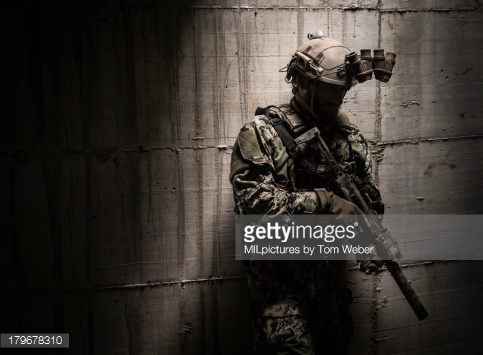
Just the suggestion that Joker is back in town is enough to cause absolute chaos not just in Gotham, but right at the heart of their police force. Over recent years a multi-media overexposure of the character has led to him becoming more savage and more predictable, and Gotham Central came at a time when we were just beginning to really enter the era of too much Joker, generally speaking.
Whilst that does affect him off-the-page, an interesting and sometimes explored aspect is how is affects the in-universe approach towards him. He causes absolute terror to Gotham nowadays, with even the mention of his name being enough to cause panics, riots, and drive cracks through the heart of Gotham infrastructure. The second issue of Soft Targets adds strength to the modern age version of Joker by not actually showing him at all. It’s all reputation.
Perhaps more than most other characters in the ol’ rogues gallery, Joker lives a lot on his reputation, because old stories show him having successes. In fact, it’s pretty easy to argue that most of his stories end with him achieving some measure of success just for having Batman engage with him. If he can show up, cause some problems of any kind before he’s punched in the face and shipped back to the Asylum, he’s going to consider that a job well done. Compare that to other villains who have a personal vendetta or campaign they’re always working on, and Joker stands fairly alone as the villain who always gets some measure of satisfaction.
Joker’s path relies on Batman getting involved at some point. Unlike characters like Two-Face, Poison Ivy, and Mr Freeze, who would happily continue playing around if Batman didn’t keep getting in the way, Joker actively plans to upset and hurt Batman specifically, and get under his skin. Through years of immediate acts – poisoning the water, killing Jason Todd, shooting Barbara Gordon – he’s always been captured or dealt with somehow, but he’s built a legacy and reputation as a result. Even Riddler, the other villain closely tied on a personal level to Batman, has none of the achievement that Joker sadistically boasts.
And because Joker has this reputation for having beaten Batman in several ways, he’s seen as the ultimate monster to Gotham’s standing. Throughout this issue we see characters reacting to the concept of Joker, and trying to deal with it how they can. You can see his presence stretch people thin just by association, with the police force getting tenser, terser, and more violent even amongst each other. A good example is the cop who starts berating a TV report in which a female journalist reports on what’s going on in the city. He yells at the television, but slips from anger to misogynistic language and insults so quickly that his partner quickly has to tell him to knock it off. In two panels the reader goes from understanding the rage to being thrown off by how immediately the character turns into something vicious and unacceptable.
Elsewhere, one of the other police officers makes a joke about Nora, the coroner who was shot in the previous issue. He gets slammed into a locker and punched, but it’s again an example of the police being shown up as being drastically affected by even the idea of Joker. He’s won this story, in his terms, before he’s even been confirmed as the shooter. Three shootings later, and even the police are starting to break apart into mad factions. There’s a real sense of power in the fact that characters like Allen and Montoya know all they can do with Joker is act as damage control – he’s a force of nature at this point, and his impact is so hard that they can only absorb the blow.
When writing about the first issue I mentioned the disposability of the characters, which is still a huge factor to hang over the series as a whole. Joker is a mass murderer and there is a huge chance that he’ll kill some regular members of the cast before the story has completed. Whilst the characters are disposable to DC as a whole – I think Maggie Sawyer may be the only characters in the series who still has a presence in the current landscape at DC – that doesn’t mean they’re disposable within Gotham Central itself. As long as the series goes on, the characters mean something to each other, and in some cases more to each other than they do to the reader.
A small scale series like Gotham Central is a better fit for a character like Joker than in the widescreen event stories which act almost as a celebration for the character. Fit him up against, say, Superman, and the character largely falls completely flat. Set him as the wild threat to a somewhat anonymous large cast of civilian characters who could all be killed off at any time? The Joker’s legacy grows a little further, even though not deeper. Because at this point, he’s largely lost as a character or personality, ironically enough – so comics may as well lean into the idea of Joker as a primal force of nature turned performance artist.
Which, in a way, is quite an interesting thing to turn around on the creative teams, and especially the writers. To what extent does their writing of Joker inform the reader of their own mindset? Joker can murder hundreds with a faceless bomb or sit quietly and wait with a sniper rifle, watching his victims before he shoots – the attitude instilled in Joker speaks volumes about the people writing him. As with so much else about Gotham Central, Joker as a faceless sniper is a more subtle and worrying turn of play for the character than we’d seen at the time. His styling as a performance artist, hooking up webcams around the city so people can count down in real time to his next act, is all about reputation and chaos: the two core traits for the character in this modern age of comics.
We still don’t even know if he has a motive. We’ve still not seen him holding the gun. But we know he’s behind this, and we know that means only horror for the police force in Gotham. That’s a effective use of legacy.
Gotham Central #13
Written by Ed Brubaker and Greg Rucka
Art by Michael Lark and Stefano Gaudino
Colors by Lee Loughridge
letters by Clem Robins





